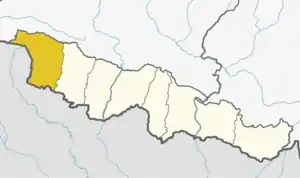Birgunj
Birgunj (also Birganj; Nepali: बीरगञ्ज) is a metropolitan city in Parsa District in Province No. 2 of southern Nepal. It lies 135 km (84 mi) south of the capital Kathmandu, attached in the north to Raxaul in the border of the Indian state of Bihar.[1] As an entry point to Nepal from Patna and Kolkata, Birgunj is known as the "Gateway to Nepal". It is also called "Commercial capital of Nepal". The town has significant economic importance for Nepal as most of the trade with India is via Birgunj and the Indian town of Raxaul. Tribhuvan Highway links Birgunj to Nepal's capital, Kathmandu. Birgunj was one of the first three municipalities formed during the rule of Prime Minister Mohan Shumsher Jang Bahadur Rana. It was declared a Metropolitan City on 22 May 2017 along with Biratnagar and Pokhara. Birgunj is one of the largest city in Nepal and largest in Province no. 2. Birgunj is the sixth most populated metropolis of the nation.
Birgunj
बीरगञ्ज | |
|---|---|
Metropolitan City | |
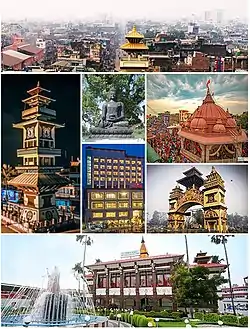 Top: Aerial view of the city from the north, second row: Birgunj Clock Tower (L), Shankararcharya gate (RB), Gahawa mai mandir (RU), Gautam Budhha Stupa (M), Diyalo Lords Plaza (M) bottom: Birgunj Townhall | |
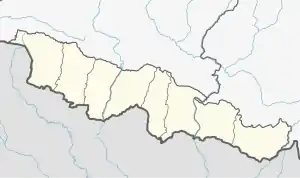 Birgunj Location of Birgunj in Province No. 2 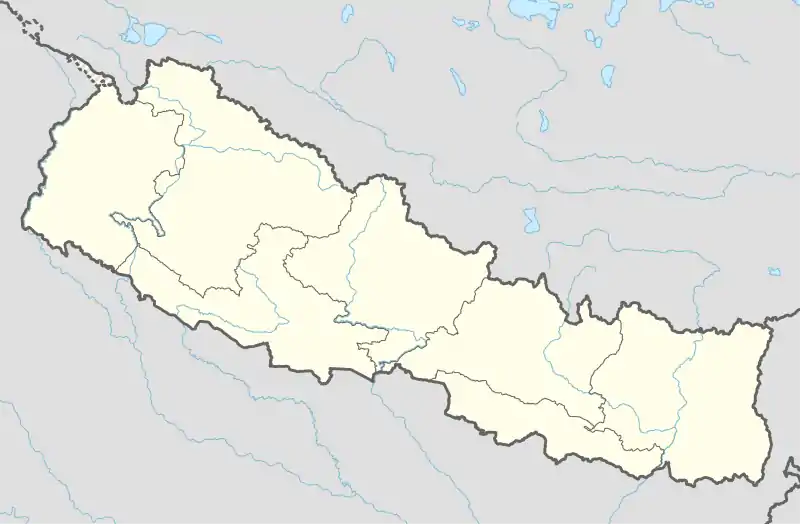 Birgunj Birgunj (Nepal) | |
| Coordinates: 27°0′N 84°52′E | |
| Country | |
| Province | Province No. 2 |
| District | Parsa |
| Founded | 1897 |
| Founded by | Bir Shamsher JBR |
| Government | |
| • Mayor | Mr. Vijay Sarawagi (FSFN) |
| • Deputy Mayor | Ms. Shanti Karki (NC) |
| Area | |
| • Total | 75.24 km2 (29.05 sq mi) |
| Dimensions | |
| • Length | 19 km (12 mi) |
| • Width | 4 km (2 mi) |
| Elevation | 92 m (302 ft) |
| Population (2011) | |
| • Total | 204,816 |
| • Density | 2,700/km2 (7,100/sq mi) |
| Demonym(s) | Birganj |
| Languages | |
| • Official | Nepali |
| • Local | Bhojpuri |
| Time zone | UTC+5:45 (NST) |
| Postal code | 44300, 44301 |
| Area code(s) | 51 |
| Website | birgunjmun.gov.np |
Etymology
Birgunj was established as a conglomerate of several villages in and around Gahawa Mai Temple. Gahawa Mai Temple remains the epicenter of the town. The settlement was named after the Rana Prime Minister Bir Shamsher, thus acquiring the name Birgunj.
History
Ancient
Before the establishment of Birgunj, the main center of Parsa district was Alau (near Dryport), Nepal. In July 1959 From Sugauli King Rajendra Bikram Shah has a history of setting up a military camp in Alau of Parsa district.
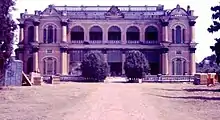
Birgunj was founded in 1897 by 11th Rana Prime Minister Bir Shamsher Jang Bahadur Rana; the ancient name was Gahawa. Before the establishment of Birgunj Bazar, the surrounding villages Baghi, Alau, Barewa, Kalaiya, Prasauni, Inaruwa, Chhapkaiya existed. To establish Birgunj Bazar in a forest covered area, Bir Shamsher Jang Bahadur Rana appointed his trusted duo Siddhvir Mathema and Dhadjavir Mathema (two brothers) respectively in Birgunj as the ruler of Mal Ada and Kath Mal Ada. In this connection, Siddhvir Mathema distributed free land and timber and provided cash assistance to the homeowners in Birgunj. The act had subsequently required Siddhvir Mathema to pay the death penalty.
After the death of Bir Shamsher Jang Bahadur Rana, Dev Shamsher Jang Bahadur Rana became Prime Minister, but within three months Chandra Shumsher Jang Bahadur Rana had driven Dev Shamsher and made himself Prime Minister. The people of Late Bir Shamsher Rana and Dev Shamsher Rana did not tolerate Chandra Shamsher Rana. Bir Shamsher Jang Bahadur Rana'special man Siddhivir Mathema, was accused of conducting an inspection of a reservoir treaty and carrying out three lakh irregularities on his forehead. When Siddhivir showed the calculations he had spent on setting up Birganj Bazar, he was declared invalid and an order was issued to pay the money immediately. After answering that he could not pay for what he did, As a punishment, the signboard was stick on his chest and move it around the market. The verbal verdict of the death sentence was decided to cut off and kill. After hearing about verbal of death sentence to Mathema who worked day and night without eating to establish Birgunj Bazar, Late Bir Shamsher Jang Bahadur Rana's wife has paid 3 lakh and rescued Mathema from the death penalty.
Chandra Shamsher also wanted to displace Birgunj Bazar, which his brother had established. He wanted to remove the Birgunj bazaar from there and set it in Rautahat. According to the move to displace the market, In 1959, it raided the main market from Raxaul to Birgunj and extended the rail line service to Amalekhganj. From the link, the train used to run around the houses, exploding and terrorizing the residents. Later, the rail link was moved to the east of the market (outside the market). The Raxaul city in India, which is currently connected to Birgunj as the main gateway to Nepal, was not established. At that time Indian trains operated only till Sugauli.[2]
Modern
On 18 May 2006, the parliament of Nepal declared that the country would become a secular state. This led to unrest by Hindu fundamentalist groups across Nepal; the town of Birgunj was forced to close for nearly two years and was disturbed for more than 10 years.[3]
Demographics
According to the 2011 Census, Birgunj had a population of 133,238.[4] It is the second biggest city in Terai and the fifth biggest city in Nepal after Kathmandu, Pokhara, Lalitpur, and Biratnagar. It serves as the headquarters of the Parsa District. Although Nepali is the official language, the native Bhojpuri language is the main language spoken. In addition to Bhojpuri, several other languages are spoken, including Maithili, Hindi, English and Newari.
Topography, geology and soils
Birgunj is located in the Terai plain which is the northern part of the Indo-Gangetic plain. Birgunj metropolitan city has an elongated shape. The variation in altitude is in the range of 78 m to 95 m when moving from south to north of Birgunj. Although the range of altitude variation is small, but there is a high micro-topographical variation. The city lies about 90 m above sea level. Quaternary sediments are mainly found in the area. Soil is very fertile that consists the mixture of clay, silt and sand.[5]
Climate
The climatic condition is sub-tropical monsoon with a very hot and humid summer. The mean annual temperature ranges from 23.8 to 24.5 °C (74.8 to 76.1 °F). The annual rainfall ranges from about 1,300 to 2,800 mm (51 to 110 in) with an average of 1,800 mm (71 in). Majority of the precipitation occurs during June, July, August and September.[6]
Surface and Ground Water
Sirsiya in the west and Singaha in the east are the two major rivers in Birgunj. Both rivers flow from north to south. During monsoon, these rivers are flooded and river bank cutting at the bends is common. The water level is very low in these rivers during winter. The depth of Groundwater table is approximately between 9–15 m (30–49 ft) deep with 1–2 m (3 ft 3 in–6 ft 7 in) fluctuation during wet and dry season.[7]
Economy
In 1964 when Birgunj Sugar Factory Ltd. was established by the Government of Nepal in collaboration with the Soviet Union (at present, Russia) with initial crushing capacity of 1,000 metric tons which later increased to 1,500 metric tons (Rajak, 2006). This was the first sugar mill established in the public sector. Later on, this mill was liquidated due to heavy losses.
Birgunj is a major business centre of Nepal, especially for trade with India. Almost all trade with India occurs through this route. The Indian border town of Raxaul has become one of the busiest towns for heavy transportation due to high trade volume. With a large number of industries set on the Birgunj-Pathlaiya industrial corridor, Birgunj produces a wide range of products such as pharmaceuticals, textiles, vegetable ghee, plastic, steel, plastic, cigarettes, aluminium, among others. Almost 56% of the total products of Birgunj are exported to the Indian state of Bihar.[8]
Birgunj Customs holds a major contribution in terms of revenue earnings in the nation. On 16 July 2004 Birganj Inland Dry Port came in operation to improve trade operation and address the concerns in handling the large volume of goods.
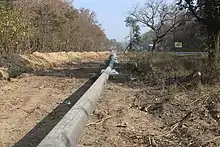
The India-Nepal oil pipeline construction that began on March 9, 2018 saw its completion up to 13 km (8.1 mi). The 69-kilometre (43 mi) Amlekhgunj-Raxaul oil pipeline connecting the two countries has been laid along the Pathlaiya-Simara-Jitpur, Parwanipur and Birgunj bypass roadway. According to the reports, major part of the pipeline alignment is covered in the Birgunj-Pathlaiya commercial highway.[9]
Tourism
Birgunj is main entry to Nepal. So, the city is widely visited by the Indians. Some of good three-star hotels to stay are Hotel Vishwa, Hotel Diyalo Lords, Hotel Diyalu, Hotel Makalu and Hotel Suraj which are in main centre of the city. These hotels operate some mini casinos as well.
 The decorative Ghadiarwa Pokhari during chhath
The decorative Ghadiarwa Pokhari during chhath Bindhyabasini Temple of Birgunj on the day of Fulpati during Dashain
Bindhyabasini Temple of Birgunj on the day of Fulpati during Dashain
During Chhath festival, Ghadiarwa Pokhari is visited by mass no people coming from whole country. Vishwa Buddha Vihar, located in the out-skirts of the city. Vishwa is actually shaped like a stupa and has engravings of Buddha facing the cardinal directions of the universe. This place has a tranquil ambiance and it attracts those tourists who want to flee the bustling life of the city. The term vishwa is derived from the word vicchu-wa, which is translated as a resting place for vicchu(s) or Buddhist monks and means a resting place. In the ancient times, the pilgrims stopped at Birgunj in the midst of their journey between Lumbini and Bodh Gaya (India). The mound is protected by a boundary wall, and future excavations may well tell us about the history of not just Birgunj but also its importance to Buddhism 2,500 years ago.
Parsa National Park which is 33 km (21 mi) from the city, known for inhabiting Royal Bengal Tigers (Panthera tigris tigris), Asian elephants (Elephas maximus), One-horned Rhinoceros (Rhinoceros unicornis), Common Leopard (Panthera pardus) and also various species of mammals, birds and reptiles. The park can visited by one hour drive by bus from the city.[10]
Transport
Birgunj was built as the closest Nepalese city connecting the capital Kathmandu with India. Birgunj railway station was connected by the Nepal Government Railway (NGR) to Raxaul station in Bihar across the border with India. The 47 km (29 mi) railway extended north to Amlekhganj in Nepal. It was built in 1927 by the British but discontinued beyond Birgunj in December 1965.[11]
Rail
Trains run to major cities of India from Raxaul station (in India, adjacent to Birgunj) and Sugauli station (17 miles from Raxaul) including the Satyagrah Express to Delhi, Mithila Express to Kolkata, Lokmanya Tilak express to Mumbai, and HYD-RXL express to Hyderabad. Thus, Birgunj has direct connectivity to major Indian cities like – Patna, Varanasi, Allahabad, Kolkata, New Delhi, Mumbai, Bhopal, Amritsar, Guwahati, Bhopal, Lucknow, Gorakhpur, Kanpur, Ranchi, Raipur, Nagpur, Hyderabad, etc. The Raxau-Birgunj-Kathmandu railway survey report has been ready and in coming future the further work will be started soon.
Air
Birgunj is served by Simara Airport, which lies 9 miles North of the city. Regular flights operate between Kathmandu & Simara. The second International Airport of Nepal is under construction at Nijgadh (22 miles from Birganj). There are plans to connect the new airport, Birgunj and Kathmandu via a "Fasttrack" expressway after its completion. This is expected to reduce travel times between the capital and the commercial capital, Birgunj
Buses
There are regular bus services to all major cities and towns in Nepal including Kathmandu, Pokhara, Patan, Bhaktapur, Biratnagar, Dharan, Butwal, Nepalgunj, Dhangadhi, Kakarvitta, Janakpur, Bhairahawa (Lumbini), Bharatpur (Chitwan), etc. Local bus services provide transportation inside the city and into its vicinity. Night buses from Birgunj to Kathmandu are the most luxurious bus services in all over Nepal. Birgunj bus park is the centre to find buses for any route,
Tanga
Horse driven carts locally called Tanga have historically been the mode of transport for the Madheshi people. Today it survives as a popular transportation vehicle between Birgunj and its sister city Raxaul.
Cargo
The 6 km (3.7 mi) railway track from Raxaul to Birgunj was converted to broad gauge two years after the Indian railways converted the track to Raxaul inside India to broad gauge. Now, broad gauge railway line connects Raxaul to the Sirsiya (Birgunj) Inland Container Depot (ICD) that became fully operational in 2005. Talks have been held to reopen the railway route from Birgunj to Amlekhganj in Nepal by converting it to broad gauge because of its socio-economic importance.
Goods are transported to and from India via Birgunj dry port, which is the key terminal of surface cargo delivery to Nepal. This cargo point on the south connects the heart of the country, Kathmandu, via another key industrial city, Hetauda. It is also served by Tribhuvan Highway, extending from the Indian border at Raxaul through Birgunj and Hetauda to Kathmandu with frequent bus service. Simara Airport — 9 mi (14 km) north near the highway in Pipara Simara, Bara district — offers scheduled flights to Kathmandu.
India and Nepal have an open border with no restrictions on the movement of their citizens. There is a customs checkpoint for the movement of goods and third country nationals.
Sports

The city has its own stadium, Narayani Stadium which is Nepal's second largest stadium after Dasarath Rangasala built on 1981. The stadium has capacity of 15,000 seats. At Present, the stadium is in poor condition.
A national level Cricket Ground is also located beside the Narayani Stadium. The cricket ground has top class outfield and a better cricket pitch. National level and Regional level cricket tournament are regularly held here. Every year day night T20 Cricket tournament is held using temporary flood light towers. Day night cricket match in Nepal was first played here. Nepal national cricket team's players Haseem Ansari, Aarif Sheikh, Avinash Karn and Irshad Ahmed hail from Birgunj. Cricket is the most popular sport and is played more than any other games and sports.
Education
Birgunj has some history in Education. Education was started in town with the establishment of Trijuddha School by Juddha Shumsher Jang Bahadur Rana during his regime which was among the first three schools to be established in Nepal. Currently, Trijuddha School is the second oldest school in Nepal. It serve classes in both English and Nepali Medium and also conduct diploma for civil engineering.
Thakuram Multiple Campus is the first campus (outside Kathmandu valley) in town as well as in Narayani zone. This city has made a rapid development in the field of education by the establishment of many schools and colleges like Moonlight English Boarding School, Gautam School, Alpine Secondary School, Gyan Jyoti Higher Secondary School, GHP secondary school, Shree Adarsha Secondary School, Kadambari Academy, National Infotech college, Birganj College Pvt. Limited, Gurukul Academy, Gyanda Academy, Siddharth College, BPC College, Hari Khetan Campus and Shri Narshingh Madhyamik Vidhalaya.
It has many commerce colleges and a medical college, National Medical College Birganj, The Himal Institute of Health Science, where students from all over Nepal and India come to study.
Media
Birgunj has many FM Community radio stations including Narayani FM 103.8Mhz, Terai FM, Radio Birgunj, Bhojpuriya FM, Indreni FM, Radio Bindas, Birgunj Musical FM, City FM, Aawaz FM, Public FM etc. It has also different television stations: My Televison, TV Birgunj and Birgunj Television (BTV). Many local newspapers like Prateek, Loktimes Daily, Kripa, Bhojpuri Time, birgunjsanjal, Jana Aawaz etc. are published. Some popular online news site like Yatra daily, Nepal Post Daily, Aapan Birgunj,etc. are from Birgunj. TEDxBirgunj was successfully held on 17 December,[12] that was the first ever TED event conducted in Terai region of Nepal.
Health
Narayani Hospital is one of the oldest government hospital of Nepal. It is the central hospital of government of Nepal. National Medical College[13] under TU and Kedia Dental College[14] also under TU are two major institutions providing health facilities. There are many other big and small hospitals, and international standard diagnostic centres throughout the city such as Asharam Hospital, Gandak hospital, Advance Medicare Hospital, Kedia eye hospital, Bhawani Hospital, Mangalam Diagnostic Centre, Vision Diagnostic Private Limited, Vayodha Hospital etc. The area extending from Chhapakaiya ward No. 3 up to Gandak is full of private nursing homes and clinics. Mostly the people of Nepal from Parsa, Bara, Rautahat, Sarlahi, etc. other districts and also peoples from Raxaul and different districts of India come here for check ups & treatments.
Culture
Eid, Bakra Eid, Ganesh Chaturthi, Holi, Teej, Krishna Janmasthami, Maha Shivaratri, Durgapuja, Chhath and Dipawali are major festivals celebrated in Birgunj. Small proportion of the religious diversity of Birgunj is occupied by Buddhists. Thus Buddha Jayanti is also celebrated throughout the city. The culture of this city is not limited to religious diversity but ethnic diversity is found too. People of Madheshi ethnicity occupies greater portion of population which includes castes like Mansuri, Ansari, Khan etc. from Muslim community. Kurmi, Gupta, Sah, Shah, Singh, Yadav, Sarraf, Mahato, Rauniyar, Patel etc. from Hindu community. There is also a presence of Marwari people who migrated from Rajasthan.
Cuisine
The cuisine of Birgunj has influence of both Nepali and Indian culture. Dal, bhat, roti, vegetable curry, and achar (pickle) are the most widely consumed food items. Tibetan cuisine such as momo and chowmein are also popular among the youths and the elderly. A place named Adarsh Nagar has established its name as the center for street food where food vendors sell varieties of street food during evening time. Food such as Pav Bhaji (bread and vegetable curry) and Chaat (snack made with potato as the main ingredient) are relatively popular.
Notable people
- Ruby Rana- Miss Nepal 1994
- Usha Khadgi- Miss Nepal 2000
- Prakash Shrestha- Singer
- Samragyee RL Shah- Actress
Places of interest
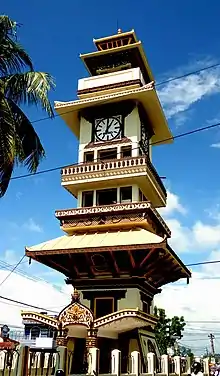
- Gadhimai Temple
- Maisthan Mandir
- Narayani Stadium
- Parsa National Park
- Simraungadh
- Ghadiarwa Pokhari
References
- "ABOUT BIRGUNJ". www.cgibirgunj.org. Archived from the original on 2017-07-12. Retrieved 2017-07-04.
- "How birgunj formed?". Birgunj Municipality Nepal. Nepal Government.
- Sangraula, Bikash (30 May 2006). "Nepal faces Hindu backlash over declaration as secular state". The Christian Science Monitor.
- "Nepal population statistics". Archived from the original on 2015-07-04.
- "Birgunj Initial Environmental Assessment" (PDF).
- "Department of Hydrology and Meteorology".
- Department of Hydrology and Meteorology, Climatological Records (various volumes and years)
- CPS, NEPAL 2013, Annual UN Report Bureau.
- "India, Nepal open South Asia's first cross-border oil pipeline". www.aljazeera.com. alzajeera.
- Park, Parsa National Park. "Parsa National Park". Parsa National Park. Government of Nepal.
- "Transport in Nepal". nepal.saarctourism.org. Archived from the original on 2008-12-29. Retrieved 2008-12-20.
- "TEDxBirgunj".
- "National Medical College Birgunj".
- http://www.mbkediadentalcollege.com
